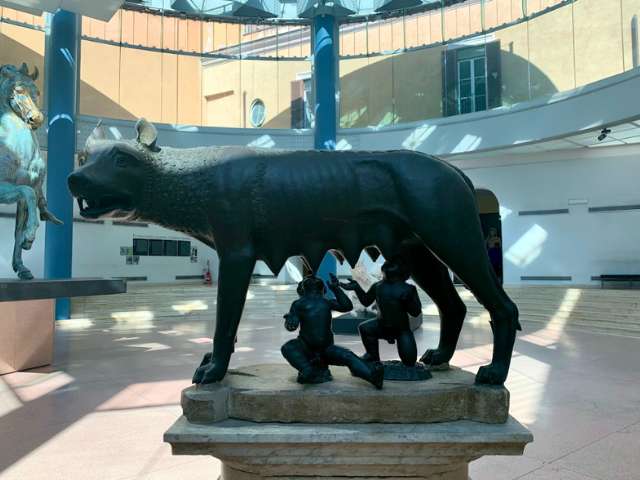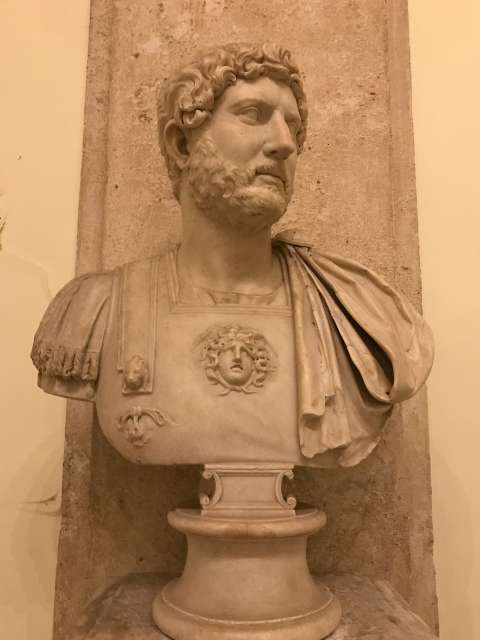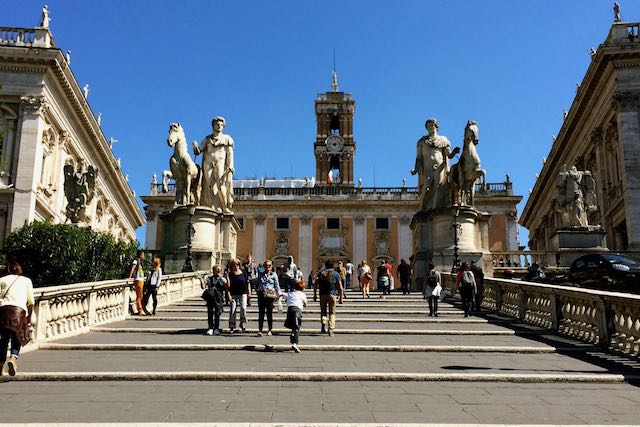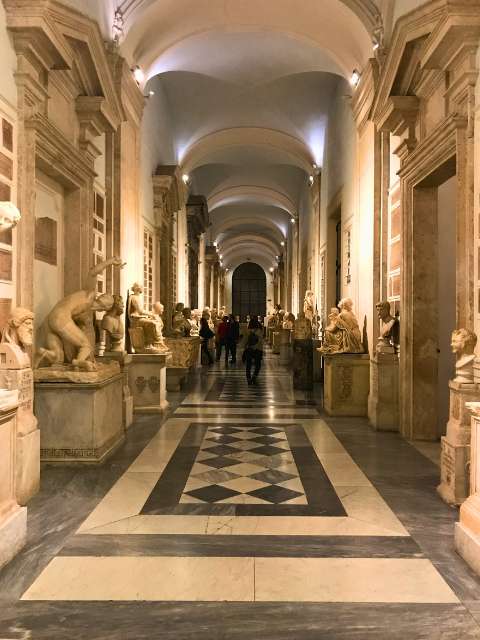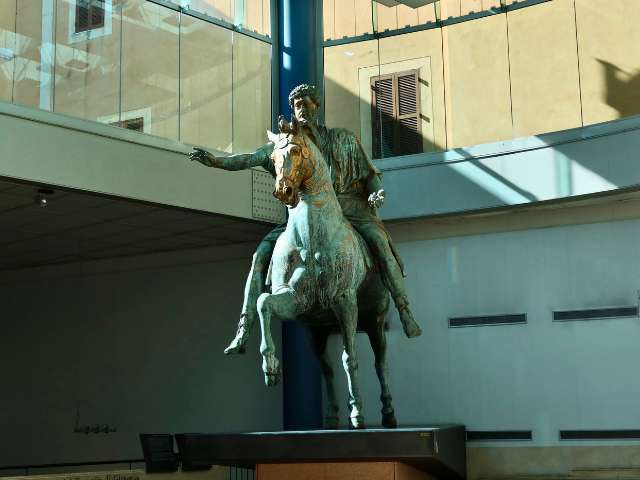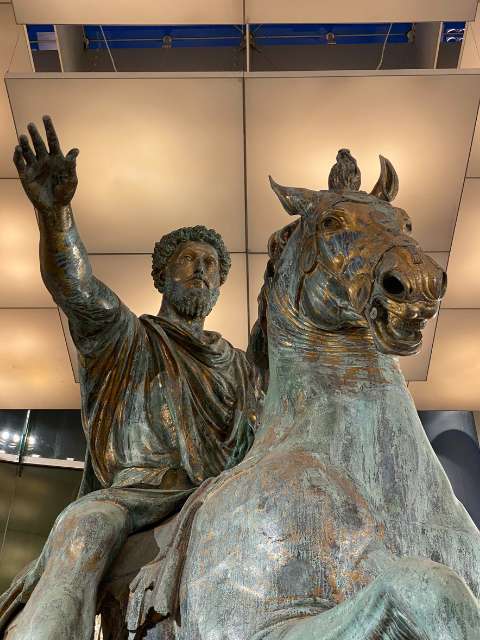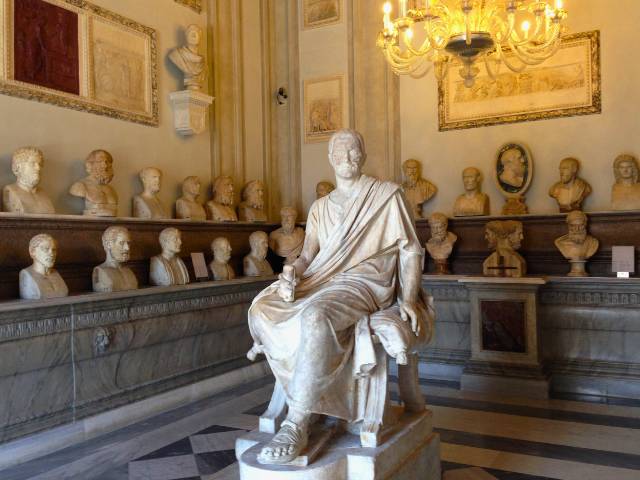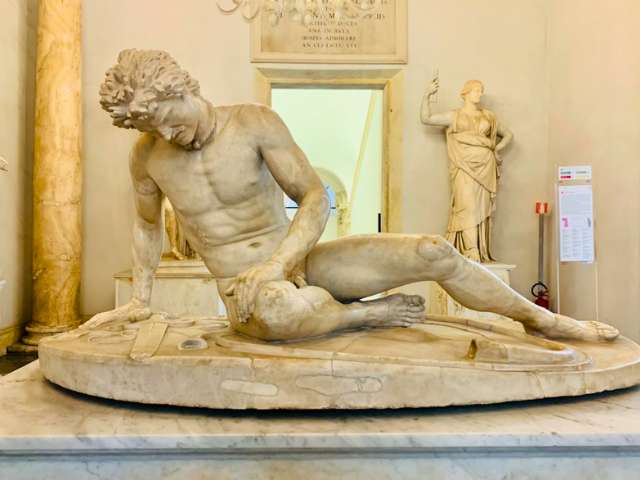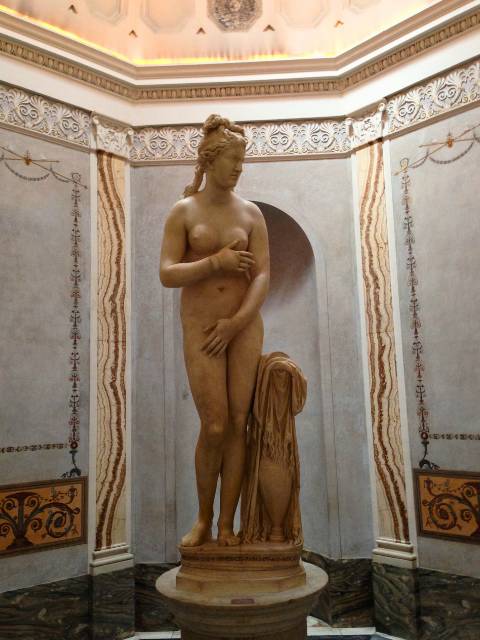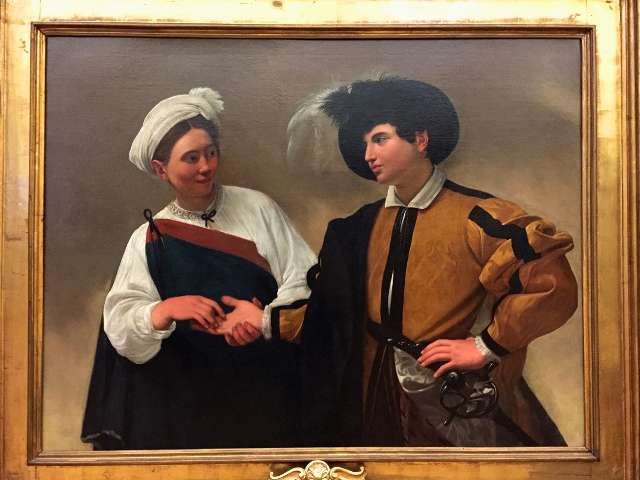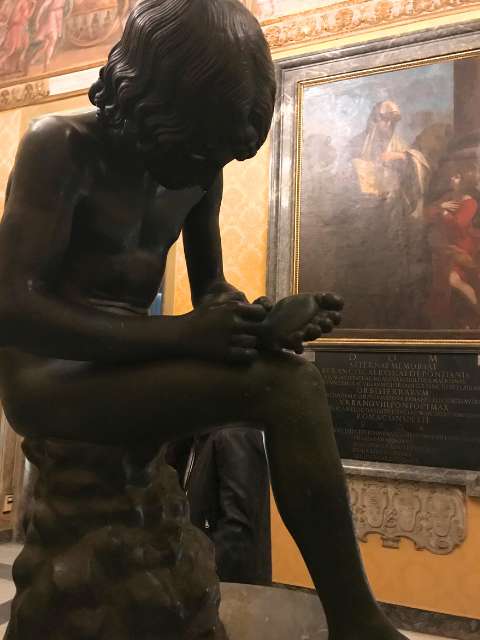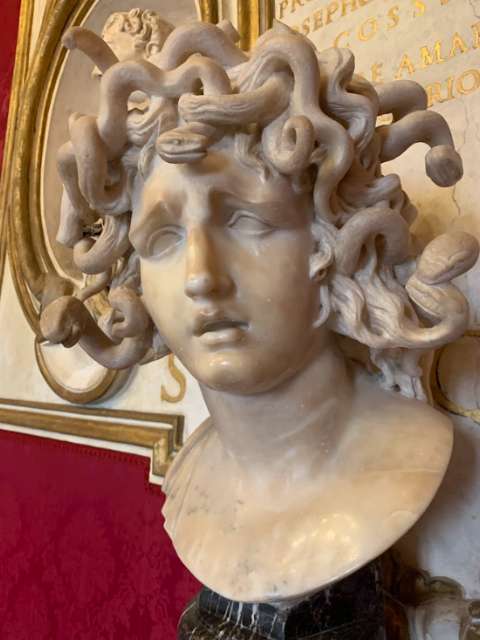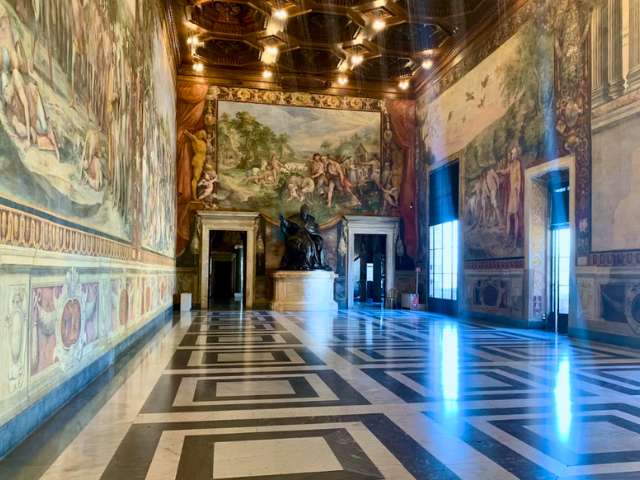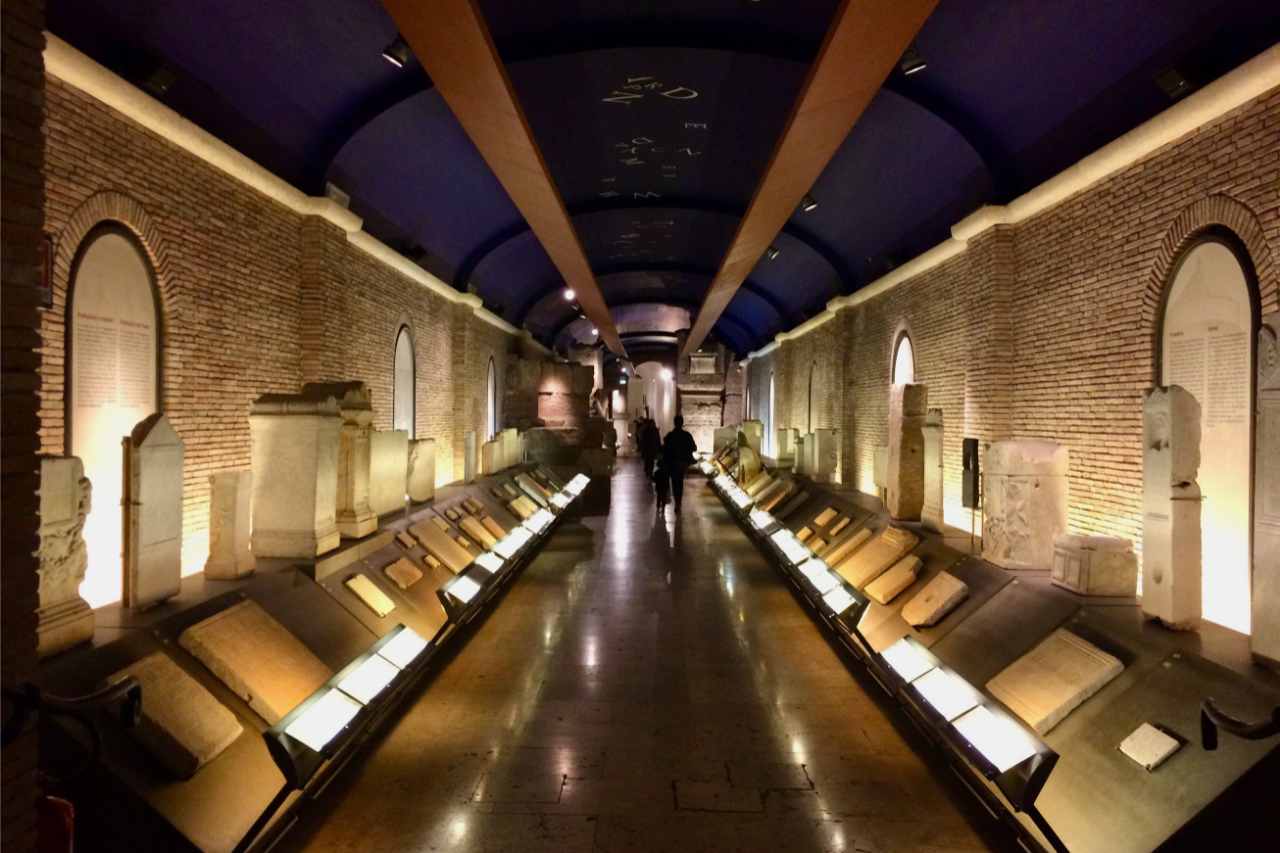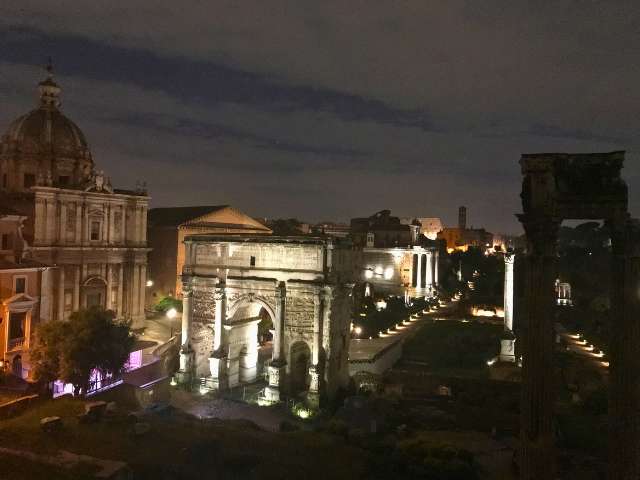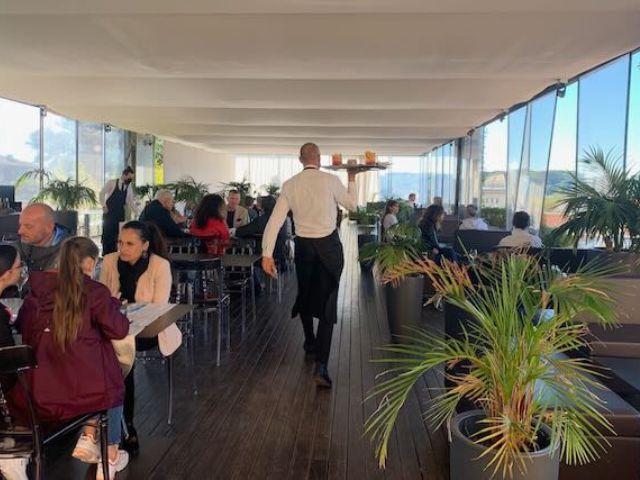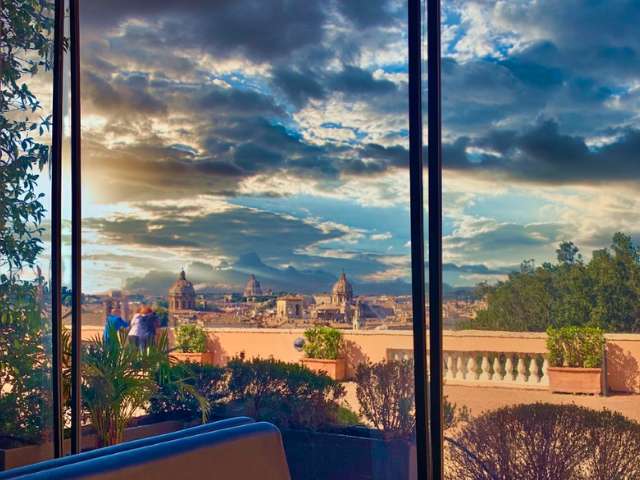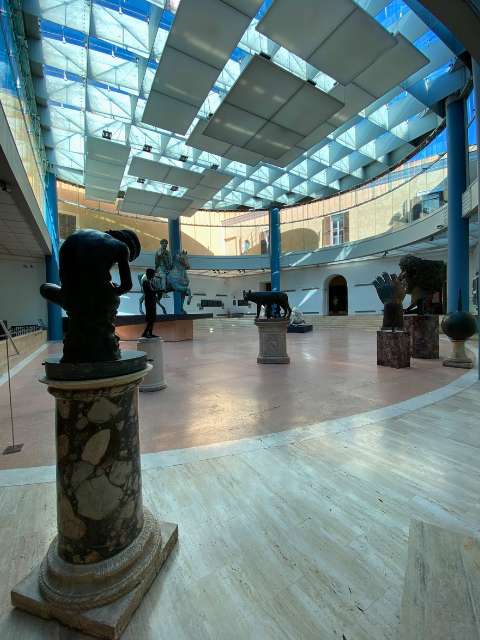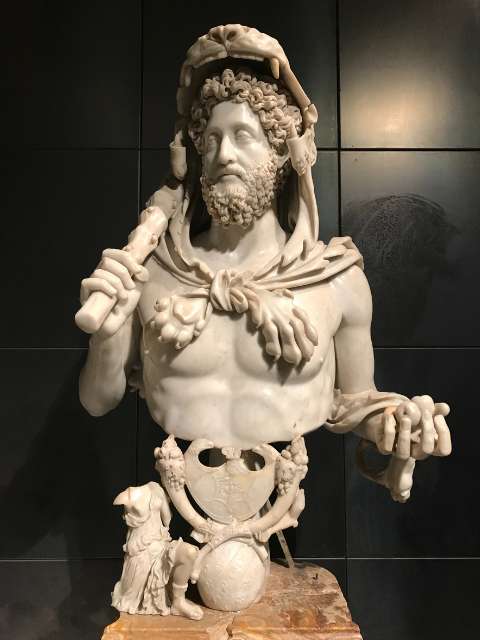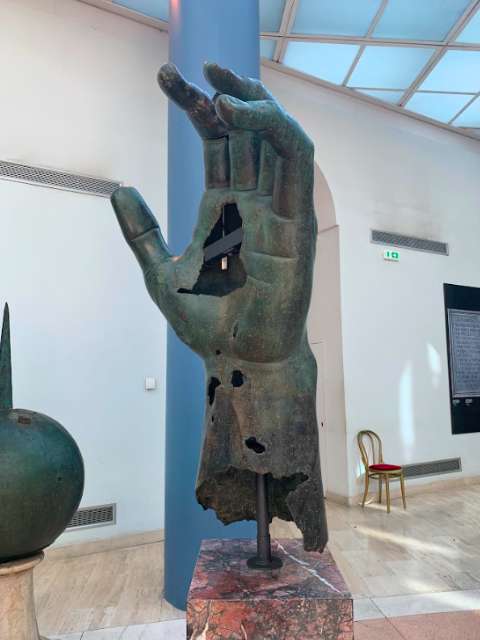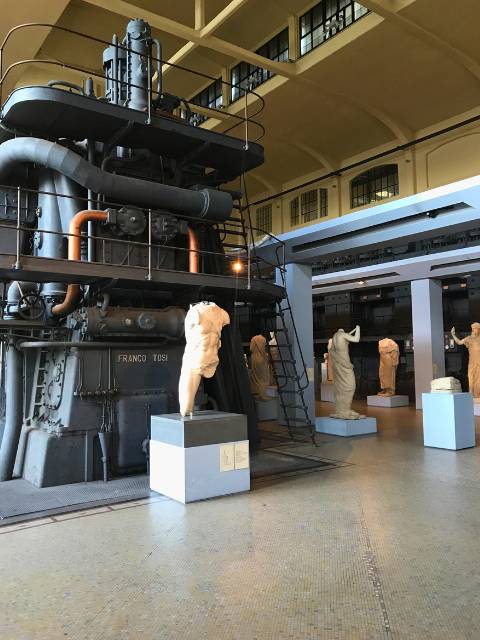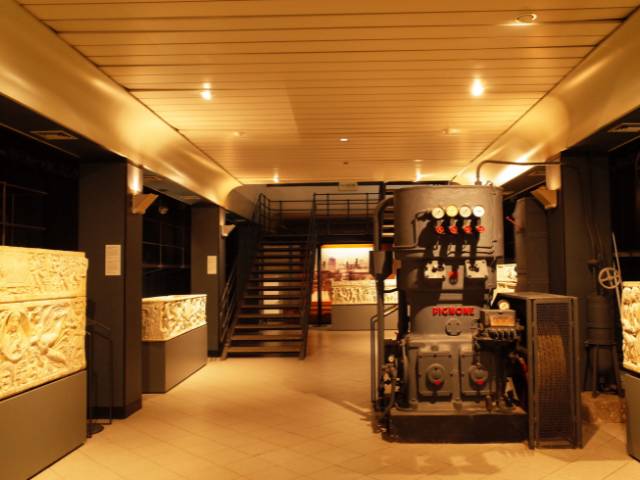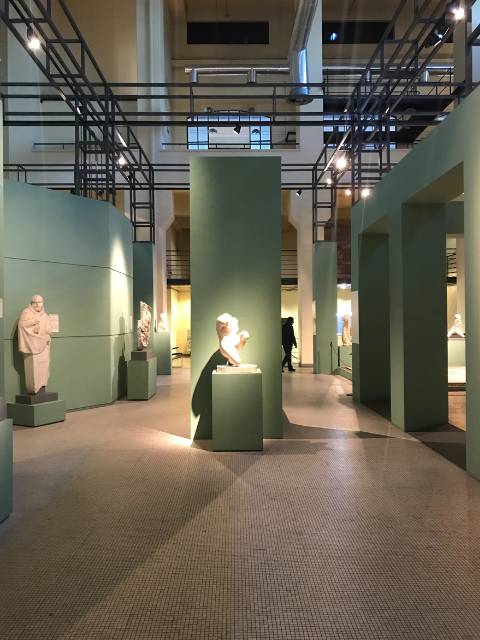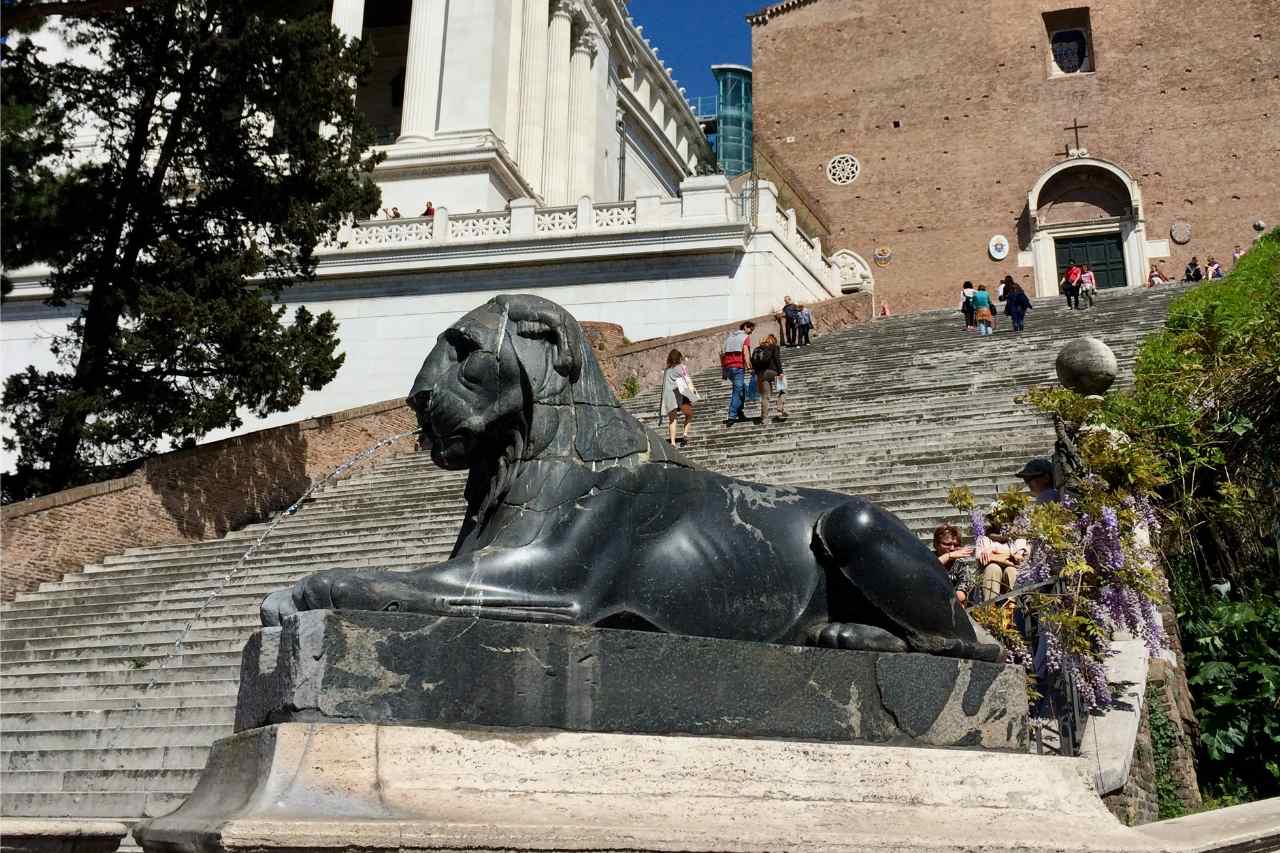- Sign up & get a FREE ebook Subscribe NOW!
- Romewise Home Page
- What to Do in Rome
- capitoline museums
Capitoline Museums Rome tickets - Know before you go!
Why visit the Capitoline Museums Rome?
I find this museum is often not on most people's lists of things to see in Rome, especially for first-time visitors.
But to me, it's one of the best and most important museums in Rome.
Why?
Read on to find out what's inside the world's oldest museum and what you should see there!
Visiting the Capitoline Museums Rome - Everything you need to know
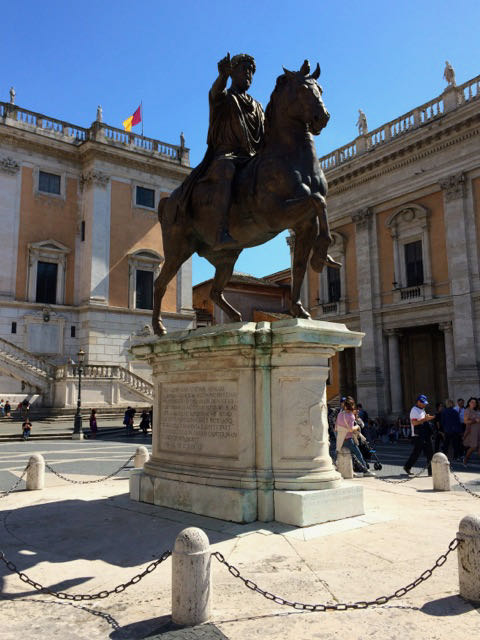 While the original statue once stood here, it was replaced by this replica and the original moved inside the museums
While the original statue once stood here, it was replaced by this replica and the original moved inside the museumsYou see that statue of Marcus Aurelius standing in the center of Piazza Del Campidoglio on the Capitoline hill?
It's a replica.
The original is inside the Capitoline Museums.
Want to see the original bronze she-wolf or lupa, the symbol of Rome?
Along with colossal statues, the only equestrian statue existing from Antiquity and a stroll past numerous emperors, they are all inside the museums' wonderful rooms.
Looking for some Caravaggio paintings?
You'll find two inside the museums.
There is an extraordinary wealth of art and other wonderful statues in these galleries and it's worth taking the time to visit them.
Here's everything you need to know about visiting the Capitoline Museums in Rome:
- Why are the Capitoline Museums important? What are they known for?
- What is there to see inside the Capitoline Museums?
- How long does it take to visit the Capitoline Museums?
- The best way to book your tickets for the Capitoline museum collection
- Can you take a guided tour of the Musei Capitolini? Should you take a guided tour?
- Are the Capitoline Museums worth visiting?
- What is the Museo Centrale Montemartini?
- Capitoline Museums practical information - location & hours
Why are the Musei Capitolini important?
The Capitoline Museums, the Musei Capitolini in Italian, are on top of one of Rome's seven hills, the Capitoline Hill (obviously!) at Piazza del Campidoglio.
They are called the Capitoline Museums (plural) because they are comprised of three separate but connected main buildings:
- Palazzo Senatorio - originally a 12th-century building that was eventually modified by Michelangelo to fit in with the other two.
- Palazzo dei Conservatori - built in the mid-16th century and redesigned to Michelangelo's specifications.
- Palazzo Nuovo - built in the 17th century to match the design of Palazzo dei Conservatori and to face it symmetrically on the piazza according to Michelangelo's designs.
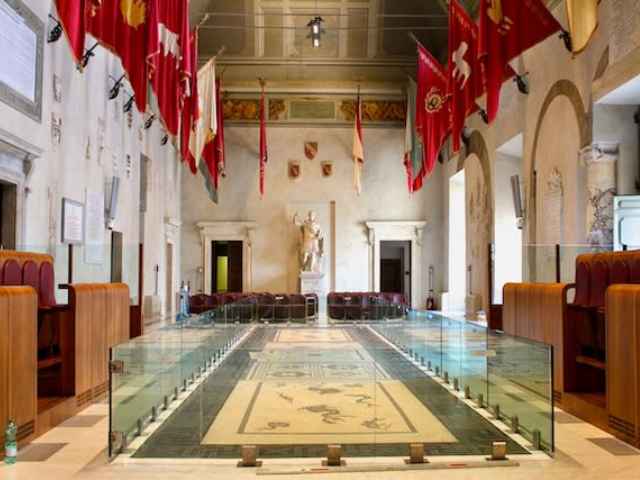 Palazzo Senatorio is the home of Rome's town hall so is not part of the visitor route in the Capitoline Museums
Palazzo Senatorio is the home of Rome's town hall so is not part of the visitor route in the Capitoline MuseumsThe collections began in 1471 when Pope Sixtus IV donated a collection of important ancient bronzes to the people of Rome.
Over the years, the collection grew and today the Capitoline Museums boast statues, art, jewelry, coins, and many more artifacts, mostly from ancient Rome.
In 1734, the museums opened to the public on the Capitoline hill under Pope Clement XII.
This was an important moment as it meant that art was able to be seen and enjoyed by the people, not just the art owners and elite.
The museum also boast a stunning collection of medieval and Renaissance art, mostly inside the painting gallery.
The Capitoline Museums are owned and operated by the municipality of Rome and are considered to be the oldest museum collection in the world!
🙌 See The Capitoline Museum Your Way 🙌
Enjoy this private tour of the Capitoline Museums with priority entry and expert commentary on its most celebrated masterpieces.
What to see inside the Capitoline Museums
There are many beautiful rooms and stunning masterpieces inside the Capitoline Museums from different eras, including ancient Rome but also the Renaissance and Baroque periods.
Here are just a few of the special things to look for when you visit the Capitoline Museums:
Colossal statue of Constantine, 313-324 CE
The huge statue of the Emperor Constantine originally occupied the west apse of the Basilica of Maxentius on the Via Sacra, near the Roman Forum.
The large head, arms and legs of the statue were carved from white marble, while the rest of the body consisted of a brick core and wooden framework.
It was possibly covered with gilded bronze but if so, the statue was likely pillaged in Late Antiquity for the bronze to be used elsewhere as none remained.
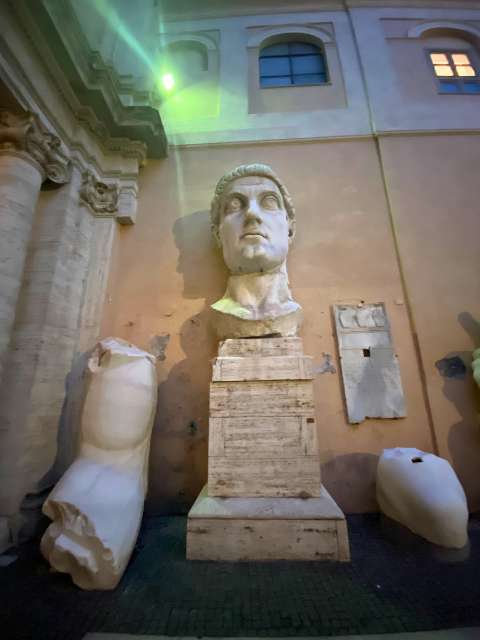 The fragments of the statue indicate how large the original statue was, it's an impressive introduction to the Capitoline collection
The fragments of the statue indicate how large the original statue was, it's an impressive introduction to the Capitoline collectionThe fine marble fragments of the statue were rediscovered in the Basilica of Maxentius in 1486.
They were later displayed in the Palazzo dei Conservatori courtyard at the ground floor of the museum.
While only the head and other fragments remain, these wonderful statues fill the courtyard with a sense of how special this museum is!
Capitoline She Wolf, 5th Century BCE
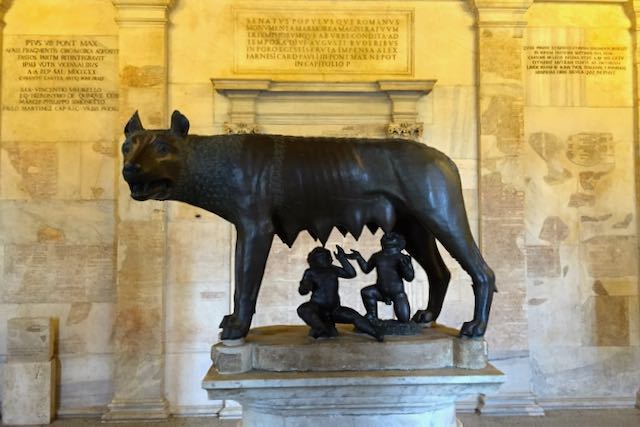 You will see this she wolf depiction time and time again all over Rome, but this is - possibly! - one of the earliest versions
You will see this she wolf depiction time and time again all over Rome, but this is - possibly! - one of the earliest versionsThe Capitoline She Wolf is a bronze statue that is the cause of some controversy.
The story of the She Wolf saving the lives of Romulus and Remus, having found them abandoned on the bank of the River Tiber, is well-known in Roman myth.
Yet the date of the famous bronze Capitoline Wolf is subject to much debate.
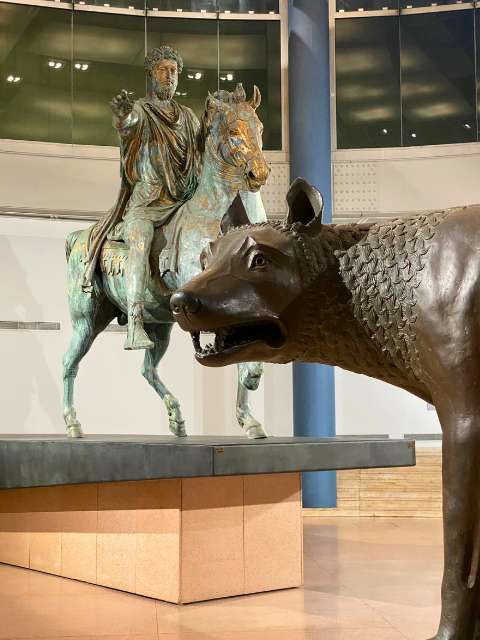 Previously displayed within its own room in the museums, the She Wolf is now on display in the newer glass-roofed hall with some of the other most famous pieces
Previously displayed within its own room in the museums, the She Wolf is now on display in the newer glass-roofed hall with some of the other most famous piecesThe description in the Capitoline Museum catalogue explains that while the statue is attributed to the 5th Century BCE, more recent analysis has suggested it may be of later medieval origins.
There is some doubt as to whether the Romans would have used the She Wolf as a symbol of the city in ancient times.
However, it has great symbolic value and is an interesting representation of Rome's founding myth, complete with the children Romulus and Remus beneath the wolf.
Equestrian Statue of Marcus Aurelius, 176 CE
Among the most impressive of the bronze statues in the Capitoline Museums is the statue of Marcus Aurelius, emperor of Rome from 161 to 180 CE.
The great leader is depicted upon a horse in magnificent detail.
Larger than life in size, the original sculptor is unknown.
However, we know that Michelangelo was commissioned to restore the statue in around 1539, shortly after the equestrian statue was moved to the wonderful square on Capitoline Hill.
The great artist and sculptor recognized that the place for the central statue to stand should be in the middle of Piazza Del Campidoglio, where it dominated the surroundings.
A fine and remarkable piece, there were once 22 recorded equestrian statues in Rome, of which this representation of Marcus Aurelius is the sole surviving example.
The original was restored and moved into the central glass covered hall in the 1980's, when the replica was also created and placed in the Piazza del Campidoglio outside.
The Halls of Emperors and Philosophers
The Hall of Emperors has a series of imperial marble busts from the Albani collection.
They were purchased in 1733 for the Capitoline Museums by Pope Clement XII, becoming the foundation of the collection.
The busts are displayed in chronological order, from Augustus to the emperors of late antiquity.
The Hall of Greek and Roman Philosophers contains the busts of poets, philosophers and orators from the classical era.
Many of the portraits are late reproductions and were carried out after the lifetime of the characters they represent, giving them a sense of authority they maybe didn't have in reality!
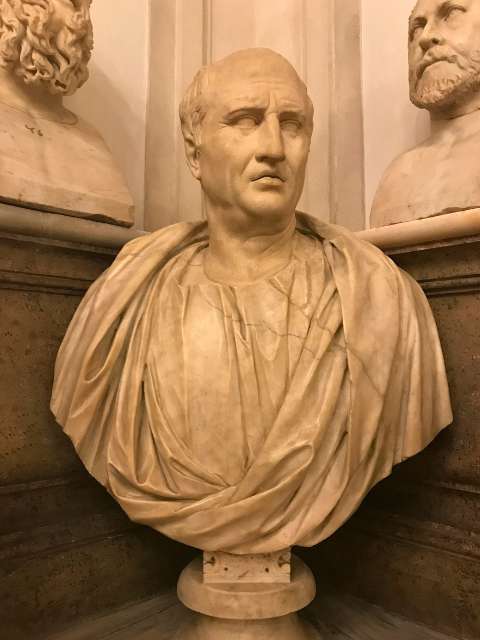 This bust of the famous ancient Roman writer and senator Cicero is just one of the many on display in the Hall of Philosophers
This bust of the famous ancient Roman writer and senator Cicero is just one of the many on display in the Hall of PhilosophersThe Dying Gaul, 1st or 2nd century CE
Originally known as 'The Dying Gladiator', this spectacular and rather beautiful marble sculpture was identified as a Gaul or Galatian in the 19th century.
Attributed to the artist Epigonus, it dates back to the 1st or 2nd century CE.
The dying man's pose is recumbent, supporting himself with his right hand and looking down.
It is a copy of a bronze sculpture from the Hellenistic period, the original of which is lost.
The original is thought to have been commissioned by Attalus I of Pergamon to celebrate a victory over the Galatians, a Celtic race of the era.
Capitoline Venus, 2nd Century BCE
The Capitoline Venus depicts the Goddess in a pose popular at in ancient times.
She stands upright, having just bathed, one hand almost covering her breasts, the other her groin.
This pose is often repeated in art history and known as 'Venus Pudica' or the 'Modest Venus'.
As with several sculptures in the Capitoline Museums, this Venus is believed to be a copy of a lost Hellenistic period original, dating from the 3rd or 2nd century BCE.
Slightly over life size, this example was discovered in gardens belonging to the Stazi family.
Pope Benedict XIV purchased the Capitoline Venus from the family in 1752 and promptly gifted it to the museums.
It remains to this day in its display niche, known as 'the Cabinet of Venus.'
Caravaggio, St John the Baptist
One of two important works by the great Caravaggio in the Capitoline Museums is this captivating painting depicting a young, nude St John the Baptist.
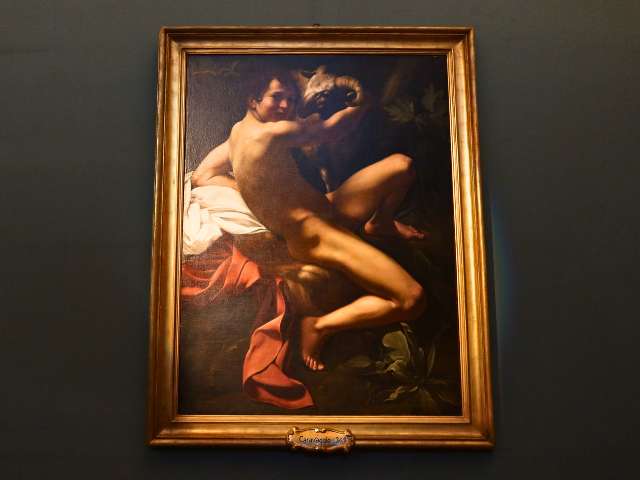 This depiction of St John the Baptist by Caravaggio is unusual in that it shows him as a younger man
This depiction of St John the Baptist by Caravaggio is unusual in that it shows him as a younger manUsually John the Baptist was shown with specific items, helping non-literate people identify him, but Caravaggio's version does not have these.
Thought to have been created between 1602-03, this masterpiece was intended for private ownership rather than to be displayed in a church, so the typical religious additions were not included in the picture.
Caravaggio, The Fortune Teller
The Fortune Teller painting is classic Caravaggio.
He was remarkable in his time for often painting ordinary people rather than religious subjects, showing them as they actually were rather than an idealized version.
In this painting the young Romanian girl, the Fortune Teller of the title is holding the hand of a Roman noble, presumably telling his fortune.
The magic of the painting is that it takes a minute to realize that she is removing a ring from his finger, taking the scene to another level of interest.
The life of Caravaggio
Want to learn more about Caravaggio's life and works?
This biography by art historian Andrew Graham-Dixon balances an in-depth account of Caravaggio's history along with reproductions of some of his most famous works.
Disclosure: If you make a purchase through a link on this page, I may receive a small commission - at no extra cost to you. Thank you for supporting my site!
Spinario (Boy with a Thorn)
Boy with a Thorn, or the Spinario, is a fascinating bronze sculpture in the Capitoline Museums.
One of several examples of a popular figure from the Hellenistic period, it is believed to date to the 3rd century BCE and depicts a young boy removing a thorn from his foot.
This example has been identified as a Roman copy, and is a particularly fine one.
The subject is a messenger, a simple shepherd boy, who ran to the Roman Senate to deliver his message.
Only after his duty did he stop to remove the thorn.
The ancient Senate commissioned the statue to commemorate the event and so it was preserved for us thousands of years later!
Medusa, Gian Lorenzo Bernini
A popular figure in classical sculpture, the Medusa in the Capitoline Museums is by the great sculptor Gian Lorenzo Bernini.
It is unusual that rather than showing the snake-haired mythical character as vanquished, it shows her as a living being.
Hall of the Horatii and Curiatii
The Great Hall of the Capitoline Museums is often called the Hall of the Horatii and Curiatii, after one of the spectacular frescoes by Giuseppe Cesari in this space.
The magnificent cycle of frescoes in this exceptional room was commissioned in 1595 and finished in 1640 after a break of twenty years.
There are six artworks that tell the legend of the founding of Rome, beginning with the tale of the She Wolf and finishing with Romulus Tracing the Boundaries of Rome.
The Great Hall was originally the space where public hearings of Rome's governing council were held and is an amazing room to spend time in.
Bronze Hercules, 2nd century BCE
The Bronze Hercules in the Capitoline Museums is believed to date from the 2nd century BCE and is a typical depiction of the young mythological figure.
It is thought that the statue was originally located in a temple dedicated to Hercules that was originally in the Forum Boarium near the Tiber river.
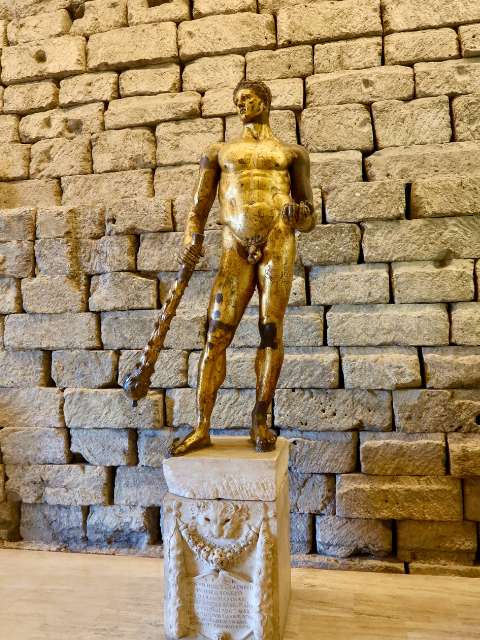 The pose and large club are often seen on depictions of Hercules, if you spend any time in Rome you will likely see it again and again!
The pose and large club are often seen on depictions of Hercules, if you spend any time in Rome you will likely see it again and again!Hercules is sculpted with exaggerated muscular features and (deliberately to enhance the height) a head slightly smaller than the proportions we would expect.
This bronze is most likely a copy of 4th century BCE examples as it is closely linked to the style of the great Greek sculptor of that era, Lysippus.
Lapidarium
The Lapidarium or Galleria Lapidaria is a lengthy tunnel connecting the two elements of the Capitoline Museums.
Along the tunnel is the museum's fascinating collection of ancient written artifacts displayed in an underground gallery.
This was built upon the ancient Roman Tabularium, the ancient state archive.
The Lapidarium is also the ideal place to view the Roman Forum with its ancient ruins adjacent to the museum.
This is an opportunity for history buffs to view rare and unique documents from Rome in antiquity within the ancient public Roman archive.
The perfect 3-day itinerary in Rome
Trying to figure out how to organize your visit to Rome? I've got the perfect 3-day itinerary for first-time visitors (or those who have not been here in a while.) It works for a 2.5 day visit as well.
In my 3-day itinerary, you'll see all the major must-see Rome attractions like the Vatican, Colosseum, Trevi Fountain, Pantheon, Piazza Navona, Spanish Steps, and much more.
And if you have more time, or want suggestions for extra/other things to do, you'll find that there too.
Visit my page with the best 3-day itinerary in Rome for first-timers.
How long does it take to visit the Capitoline Museums?
The museum complex is really quite large and a thorough visit can take anywhere from 1-3 hours.
You'll need an hour at a minimum but I think 2 hours is a good amount of time.
As with most museums of this scale, once you are inside for a couple of hours, your energy and interest may start to flag a bit.
Caffarelli Terrace and café
Luckily there is a lovely café on the roof of the Palazzo dei Conservatori where you can take a break.
It's actually one of Rome's best-kept secrets!
So if you need to have a rest, you can head there and refresh with a coffee or lunch and then continue your visit.
BONUS!
The café is open to non-museum guests as well. You just have to know where the entrance is on the side of the building.
There are guards checking tickets when you go in and out of the café so you cannot sneak in without a valid ticket.
Booking tickets for the Capitoline museum complex
While you can purchase Palazzo dei Conservatori tickets to enter the Capitoline museum on the day at the ticket office, I highly recommend booking in advance.
How to book your Capitoline Museums tickets
You can book directly on the Capitoline Museums' official website here, choosing the date and entry time that suits you.
The current cost of adult tickets is €17.
The entrance price does sometimes change depending on what exhibitions are currently active, as there can be a small additional charge for those.
Do you have to book the Capitoline museums in advance? Can you skip the line?
You can book tickets in advance but you can also purchase them on site.
A lot of the time you can purchase them on site without too much of a wait, but the queues can get really long on weekends and holidays.
And frankly, Rome has been so busy lately that I am seeing lines at the Capitoline Museums on pretty much any given day of the week when I walk past.
If you book online, you will be able to skip the line of people waiting to purchase tickets, which can be a huge time saver when it's busy.
Can you visit the Capitoline Museums for free?
The Capitoline Museums have free entry for:
- Rome residents who possess the MIC card
- Children under the age of 6
- Tour guides
- A person with a disability along with their caregiver
- Anyone with a Roma Pass or similar City Pass who is using these museums as one of their allotted free sites to visit
- And many more. See the official website for all the conditions.
Free admission to the Musei Capitolini is also available to everyone on the first Sunday of every month.
Expect really long lines and crowds as you cannot pre-book for the free Sunday.
Remember, if you're booking online and one or more of your group are entitled to free entry, you need to add as these free tickets to the online order.
It sounds odd, but while the entrance is free, the Capitoline museum staff need to know how many people will be in the buildings.
Can you take a guided tour of the Musei Capitolini?
If you prefer to explore at your own pace, the Rome Civic Museums system has its own free app you can download before visiting which includes a guide to the exhibits.
There are also plenty of descriptive signs as you move through the museums.
But like most museums of this size and importance, there is nothing like having a guided tour with someone knowledgeable to lead you through the collections.
When it comes to handling the museum entry and exploring the entire collection in-depth, a tour guide will ensure you have a smooth and enjoyable visit.
I will always recommend booking a guided tour, especially if it's your first time visiting.
Is the Capitoline Museum worth visiting?
By now you might already know what I am going to say.
If you read other pages on this site, you'll know how much I love all the museums and sites we have in Rome.
But this museum in particular is so worth a visit if you have time!
If you came to Rome looking for ancient Roman art and architecture, there is an absolute wealth of it in this space.
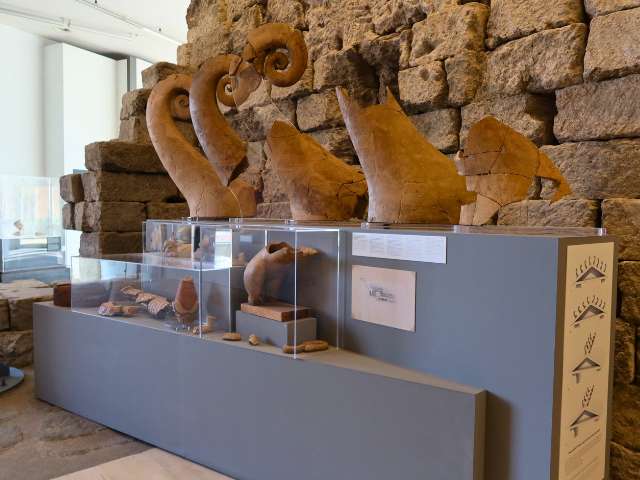 There aren't many places you can see the remnants of ancient Roman temples alongside Caravaggio paintings all in one location
There aren't many places you can see the remnants of ancient Roman temples alongside Caravaggio paintings all in one locationNot only that, but you'll find these museums usually fairly uncrowded once you're inside, which makes for a much more pleasant visit than the Vatican Museums lately.
Sorry, you know how much I love those museums, too, but they've become a really intense place to visit recently!
Finally, you will see things many people never see because they skip this museum.
I truly believe a visit here will enrich your visit to Rome.
Ready to plan your trip?
Book your train
Planning to travel between cities in Italy and other parts of Europe?
Use Trainline to see all the different options available across the different rail companies.
Find your hotel
Find your perfect place to stay in Rome.
Use Booking.com to choose between hotels, guesthouses, and self-catering apartments in neighborhoods throughout the Eternal City.
Buy your TurboPass
Purchase the convenient Turbopass and visit all of Rome's top attractions including the Colosseum, Pantheon, and Vatican.
With one handy pass, it's all included.
What is the Museo Centrale Montemartini?
The Museo Centrale Montemartini is a sister collection to the Capitoline Museums, housed in a disused power plant slightly out of the center of Rome.
The monumental complex opened in 1997 when many sculptures and archaeological artefacts were transferred from the Capitoline Museums, which at the time were undergoing a major restoration.
These art galleries allowed visitors to continue to view important statues and remains while the Capitoline was closed.
What is particularly fascinating in that the contemporary era machines in the old power plant have been restored to display condition.
An initial exhibition combining the ancient and the modern was named 'The Machines and the Gods' and opened in October 1997.
Originally intended as a temporary exhibition, the response from the public was overwhelming, and it was quickly decided to make it a permanent museum.
The Museo Centrale Montemartini has been expanded over the years and continues its original relationship with the Capitoline Museum, displaying exhibits in storage and out of sight for many years.
Tickets can be purchased that allow entry to both museums, and I recommend going for this option to see ancient statues in a unique and spectacular setting.
Practical Information about the Capitoline Museums
Open daily from 9:30am-7:30pm with last admission one hour before closing time.
The Capitoline Museums are on the Piazza del Campidoglio, also known as Capitoline Hill.
To reach the museum by metro, take the Metro B Line to the Colosseum (Colosseo) station, then it is a short 10-minute walk along the Roman Forum towards Piazza Venezia and around to the steps up the hill.
To arrive by bus, there are a number of routes that stop at Piazza Venezia or nearby, and then it's just a short walk across the street.
The entrance to the Capitoline Museums is located up the staircase on the right of the Altare della Patria monument in Piazza Venezia.
Romewise's Top Travel Resources
Ready to book your trip to Rome? Take a look at these helpful links to companies we use and trust:
- Keep your travel spending simple with the Wise card, which removes all the worry about exchange rates and high transaction fees all over the world
- Search for and book your perfect accommodation
- Our complete guide to what to pack for Rome
- The number one travel accessory, a multi-point travel adapter and voltage converter
- Browse a huge range of tours in Rome and beyond
- Experience unique tours and special access to Rome's most popular sights
- Protect yourself with comprehensive travel insurance
Within this post there are some affiliate links for products and services. For more details about our affiliate policy click here.
Get your 100% free Rome trip planner now!
Simply sign-up today for our free newsletter and get the Romewise Quick Start guide to Rome:
We are committed to respecting your data. Click for our Privacy Policy.
Comments? Questions? Suggestions?
Please come over to the private Romewise Facebook group and join in the conversation.
You will often find me there, happy to answer your questions / comments!
You will also meet other Rome lovers and experts, too.
What are you waiting for?
- Romewise Home Page
- What to Do in Rome
- capitoline museums

